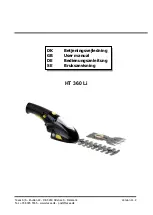
11 ENGLISH
FUNCTIONAL
DESCRIPTION
CAUTION:
Always be sure that the tool is
switched off and the battery cartridge is removed
before adjusting or checking function on the tool.
Installing or removing battery cartridge
CAUTION:
Always switch off the tool before
installing or removing of the battery cartridge.
CAUTION:
Hold the tool and the battery car-
tridge firmly when installing or removing battery
cartridge.
Failure to hold the tool and the battery
cartridge firmly may cause them to slip off your hands
and result in damage to the tool and battery cartridge
and a personal injury.
►
Fig.2:
1.
Red indicator
2.
Button
3.
Battery cartridge
To remove the battery cartridge, slide it from the tool
while sliding the button on the front of the cartridge.
To install the battery cartridge, align the tongue on the
battery cartridge with the groove in the housing and slip
it into place. Insert it all the way until it locks in place
with a little click. If you can see the red indicator as
shown in the figure, it is not locked completely.
CAUTION:
Always install the battery cartridge
fully until the red indicator cannot be seen.
If not,
it may accidentally fall out of the tool, causing injury to
you or someone around you.
CAUTION:
Do not install the battery cartridge
forcibly.
If the cartridge does not slide in easily, it is
not being inserted correctly.
Indicating the remaining battery
capacity
Only for battery cartridges with the indicator
►
Fig.3:
1.
Indicator lamps
2.
Check button
Press the check button on the battery cartridge to indi
-
cate the remaining battery capacity. The indicator lamps
light up for a few seconds.
Indicator lamps
Remaining
capacity
Lighted
Off
75% to 100%
50% to 75%
25% to 50%
0% to 25%
NOTE:
Depending on the conditions of use and the
ambient temperature, the indication may differ slightly
from the actual capacity.
Tool / battery protection system
The machine is equipped with a battery protection
system. This system automatically cuts off power to the
motor to extend battery life.
The machine will automatically stop during operation if
the machine and/or battery are placed under one of the
following conditions:
Overloaded:
The tool is operated in a manner that causes it to draw
an abnormally high current. In this situation, turn the
tool off and stop the application that caused the tool to
become overloaded. Then turn the tool on to restart.
If the tool does not start, the battery is overheated. In
this situation, let the battery cool before turning the tool
on again.
Low battery voltage:
The remaining battery capacity is too low and the tool
will not operate. If you turn the tool on, the motor runs
again but stops soon. In this situation, remove and
recharge the battery.
Switch action
WARNING:
Before installing the battery car-
tridge into the tool, always check to see that the
switch trigger actuates properly and returns to
the "OFF" position when released.
WARNING:
For your safety, this tool is
equipped with the lock-off button which prevents
the tool from unintended starting. Never use the
tool if it starts when you pull the switch trigger
without pressing the lock-off button.
Ask your local
Makita Service Center for repairs.
WARNING:
Never disable the lock function or
tape down the lock-off button.
NOTICE:
Do not pull the switch trigger forcibly
without pressing the lock-off button.
The switch
may break.
►
Fig.4:
1.
Lock-off button
2.
Switch trigger
To prevent the switch trigger from being accidentally
pulled, a lock-off button is provided.
To start the tool, press the lock-off button and pull the
switch trigger. Release the switch trigger to stop. The
lock-off button can be pressed from either the right or
left side.
Adjusting the cutting angle
CAUTION:
Always be sure that the tool is
switched off before folding or unfolding the head.
CAUTION:
When folding the head for carrying
the tool or after using the tool, be sure to attach
the blade cover before folding the head.
CAUTION:
When folding the head, be careful
not to pinch your fingers between the head and
the tool body.
Summary of Contents for UN460WDZX1
Page 2: ...1 3 5 6 7 8 10 9 4 2 Fig 1 1 2 3 Fig 2 1 2 Fig 3 1 2 Fig 4 1 2 Fig 5 1 Fig 6 1 2 Fig 7 2 ...
Page 3: ...1 Fig 8 1 Fig 9 1 2 Fig 10 1 2 3 4 Fig 11 1 2 Fig 12 1 Fig 13 1 Fig 14 3 ...
Page 4: ...1 Fig 15 1 Fig 16 1 2 Fig 17 1 Fig 18 1 Fig 19 1 2 Fig 20 1 2 Fig 21 15 m Fig 22 4 ...
Page 5: ...15 m Fig 23 15 m Fig 24 15 m Fig 25 15 m Fig 26 Fig 27 Fig 28 5 ...












































